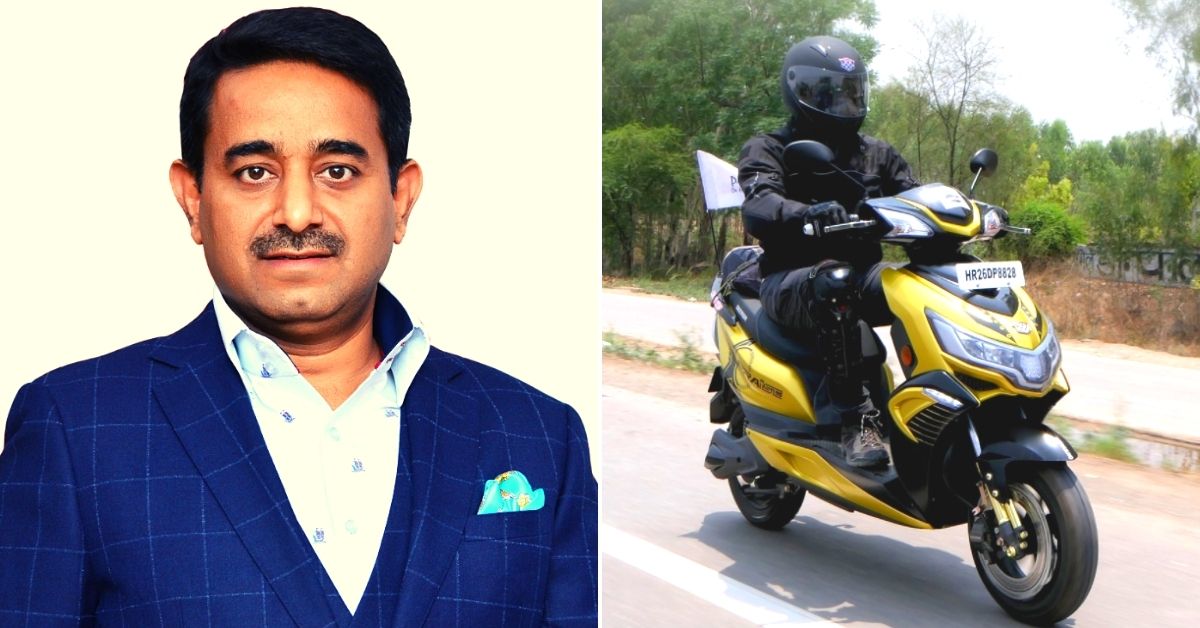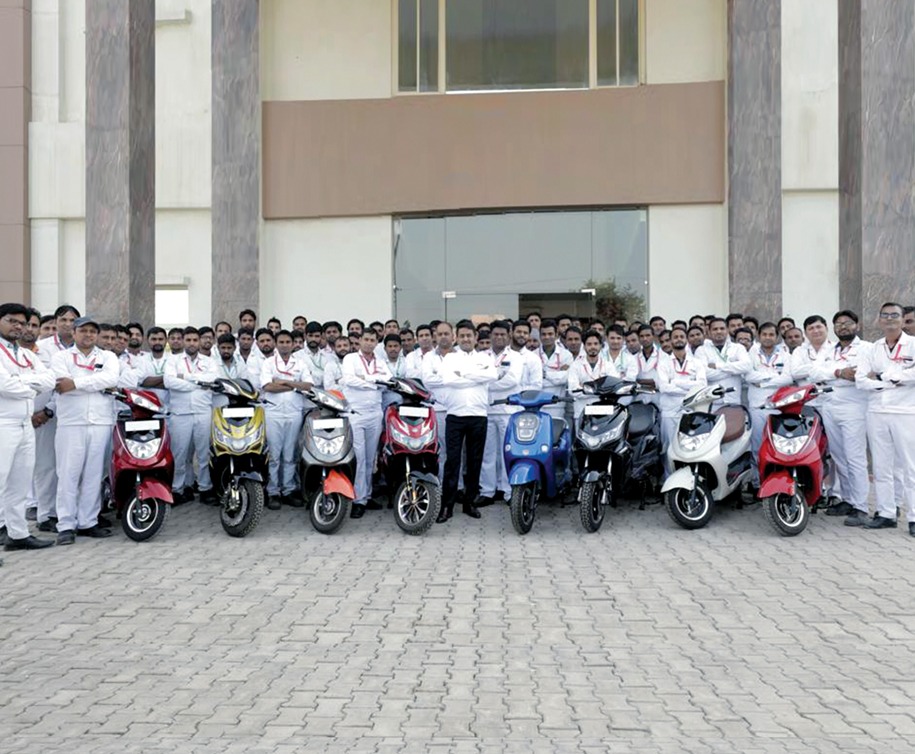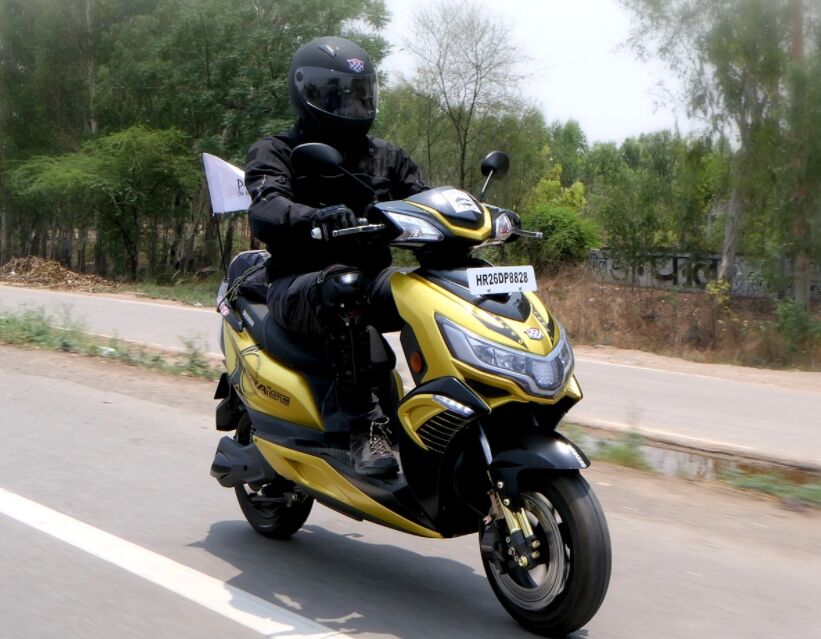Inspired by Japan, How This Gurugram Company’s E-Scooters Became Bestsellers in India
Founded in 2015, Gurugram-based Okinawa Autotech is a pioneer in the e-scooter market, and only second behind Hero Electric in terms of sales.

Okinawa Autotech, a Gurugram-based two-wheeler electric vehicle (EV) manufacturing company, sold about 4,500 units last month. With many cities imposing necessary lockdowns this month to curb the raging COVID-19 second wave, the company’s business has taken a hit since they couldn’t supply new vehicles to their over 300 dealerships.
(Image of Founder and MD, Jeetender Sharma, on the left and a Okinawa scooter model on the right.)
But in just the first 12 days this month, they have received bookings for over 2,000 vehicles both online and offline. Once these restrictive lockdowns are lifted, the company hopes to increase sales this month.
According to Autocar Professional, a leading automotive fortnightly, Hero Electric, Okinawa and Ampere Electric reportedly have a combined market share of 71 per cent of the electric scooter market in India. Of course, it’s important to note that their sales were significantly hit last calendar year because of the pandemic.
“However, our sales rapidly picked up after the lockdown and we sold around 30,000 vehicles by the end of the previous financial year, which was down from around 33,000 the year before. Before the pandemic, we were earning annual revenues of close to Rs 150 crore,” says Jeetender Sharma, Founder and Managing Director of Okinawa Autotech, speaking to The Better India.

Pioneer of the Indian EV Sector
These figures tell you that Okinawa remains not just a pioneer of the Indian EV sector but also one of its leading lights today. Founded in 2015 by Jeetender Sharma, a mechanical engineer by trade with over two decades of experience in the automobile industry, the company spent the first two years researching the EV ecosystem in India, consumer attitudes, developing and testing the prototype of their first high-speed electric scooter.
“My first job was with LML Scooter, which manufactured some of the highest-selling scooters in the middle to late 1990s, before moving to Honda Motorcycle and Scooter India Pvt Ltd in 2001. I was part of the 50-member launch team of Honda Scooters & Motorcycles in India and spent nearly 14 years with the company. There, I worked across different verticals like quality management, market intelligence and research and development. Before quitting Honda in 2015, I was heading the Supplier Quality Assurance of Honda two-wheelers, which meant overseeing the process intended to ensure that a supplier reliably supplies goods or services that satisfy the customer’s needs in the Indian, European and South-East Asian market. I had dedicated my entire life to working on or with two-wheeler automobiles,” says Jeetender.
Despite achieving significant professional goals with Honda, he had a burning desire to start something of his own.
But what would he venture into? The answer came gradually, particularly towards the latter years of his stint with Honda when discussions in developed nations were veering towards electric vehicles and sustainable mobility.
Meanwhile, in April 2012, the Indian government launched the FAME India scheme (Faster Adoption and Manufacturing of (Strong) Hybrid and Electric Vehicles in India), which began speaking out on the ill-effects of vehicular pollution and how the electrification of the domestic automobile industry was a necessary step.
Jeetender quit Honda in 2015 and spent the first six months conducting extensive market research on EVs in India and what consumers want out of them.
Back then, he argues, consumers were perceiving EVs as an indulgence for wealthy households. They would buy slow-speed EVs for their high school-going children. These vehicles, he argues, were 100 per cent slow-speed lead-acid battery vehicles with poor service and shoddy product reliability. He would hear stories from customers about how people on bicycles would overtake them on the road and their struggle to even climb up on flyovers because these vehicles didn’t have the requisite power, besides battery range anxiety.
So when the company launched their first high-speed electric scooter called the Ridge in January 2017, it sought to address all the major consumer concerns surrounding Indian EVs.
“We were among the first, if not the first venture in India, to mass manufacture high-speed electric scooters. With a top speed of 55 kmph, loading capacity of 150 kg, battery range of 88-90 km per single charge and enough power in their motor to climb over flyovers, the Okinawa Ridge was our breakthrough EV. The Ridge was greatly appreciated in the nascent Indian market with over 10,000 units sold in the first year. Naysayers said I wouldn’t even cross 500 units in the first year but they were wrong. By this time, we had also filed patents for our powertrain and our lithium-ion battery management system (BMS),” he says.
Jeetender chose the name Okinawa because of his affinity to the city in Japan. Working with Honda Japan, he visited the city and fell in love with the people, their sustainable way of life, spirit of innovation and the importance they assign to their natural surroundings. “When I started my EV venture based on green technology, we weren’t a brand with any legacy. I want my company to represent all the above said values of the city,” he adds.
Since the Ridge, the company has gone on to launch multiple high and low-speed electric scooter models, including the Praise, Ridge+, i-Praise, i-Praise+, PraisePro and Lite. The latest model currently available on the market is the IPraise+, which has a battery range of 139 km on a single charge, top speed of 58 kmph, 1000 Watt-BLDC motor with peak power of 2500 Watt and a 3.3 kWh lithium-ion (detachable battery).

Meanwhile, the company prides itself on its patented BMS backed by artificial intelligence (AI), machine learning, and the Internet of Things (IoT) ecosystem.
“Today, 92 per cent of our components are sourced locally. In the coming financial year, we are ramping this up to 100 per cent and localise our entire supply chain in India. Developing components is not an issue. We have a good team of engineers, who have worked with me in the past and other automobile companies. Normally, companies develop a component at the prototype stage and design it. While some make them in-house, others strike deals with third-party suppliers with an agreement that they cannot sell those components to any other EV company. We follow the same strategy and have our own set of dedicated component suppliers in India, who have signed non-disclosure agreements with us. This means they cannot disclose our technology or components to anyone else,” claims Jeetender.

Looking to The Future
The Indian EV market has changed significantly since the launch of Okinawa. In 2015, EVs were merely considered as cost-saving vehicles with no emphasis on quality of the product. They were seen as better than bicycles but not as good as IC-engine scooters or motorcycles. Today, consumers are a lot more discerning about EVs and in the past three years, India has seen the emergence of many new OEMs. There are many high-speed EV two-wheelers in the market that can match the experience of their IC-engine counterparts.
“I believe the Ridge played a big role in changing consumer expectations for EVs in India. Even in terms of size, the Ridge or Praise looks like IC-engine scooters if you looked at them from the front without noticing the missing silencer. Prior to these EVs, the size of such two-wheelers was very small compared to IC-engine scooters, and people weren’t even sure whether these EVs could carry two passengers on them or not,” he recalls.
In the early days, financial support to start Okinawa came from family and friends with no angel investors on the horizon. To date, they have remained a bootstrapped venture and haven’t entertained external investors. But they haven’t closed the door on external funding, and as they enter the next stage of expansion, they may seek it out.
Meanwhile, in the coming months, the company will launch their OKI 90 high-speed electric scooter and OKI 100 motorcycle. Plans are to launch the OKI 90 by the second quarter and OKI 100 in the third, while in the next financial year, they will launch the Okinawa Cruiser.

“The OKI 100 will have a top speed of about 120 kmph, a battery range of up to 200 km on economy mode, and a BMS connected to a smartphone app with AI built into it. Consumers can compare this to any IC-engine 150cc motorcycle, but with a lithium-ion phosphate detachable battery which has a capacity of approximately 4 to 4.5 kwh. The OKI 90 high-speed electric scooter will have a top speed of 90 kmph and a detachable lithium-ion battery with a battery range of more than 200 km on a single charge. As of today, all our models possess a fast-charging mode from 0 to 80 per cent in less than an hour. To achieve 100 per cent charge, it will take anywhere between two to three hours,” claims Jeetender.
Despite the hits they’ve taken during the pandemic, Okinawa remains among India’s top two-wheeler EV makers, and is not showing any signs of slowing down.
(Edited by Yoshita Rao)
Like this story? Or have something to share? Write to us: [email protected], or connect with us on Facebook and Twitter.
If you found our stories insightful, informative, or even just enjoyable, we invite you to consider making a voluntary payment to support the work we do at The Better India. Your contribution helps us continue producing quality content that educates, inspires, and drives positive change.
Choose one of the payment options below for your contribution-
By paying for the stories you value, you directly contribute to sustaining our efforts focused on making a difference in the world. Together, let’s ensure that impactful stories continue to be told and shared, enriching lives and communities alike.
Thank you for your support. Here are some frequently asked questions you might find helpful to know why you are contributing?


This story made me
-
97
-
121
-
89
-
167











